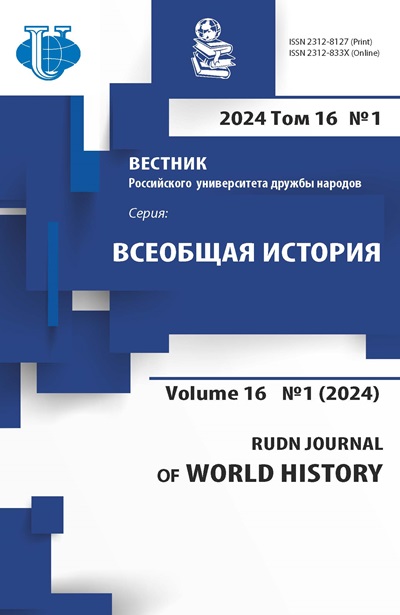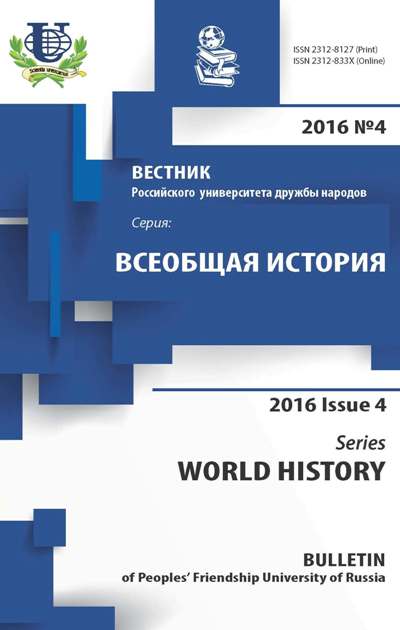No 4 (2016)
Articles
REGIME OF “GUIDED DEMOCRACY”. ON THE ISSUE OF THE FORMATION OF THE IDEOLOGY OF THE “THIRD POSITION” IN INDONESIA
Abstract
The author reveals the basic provisions of the ideology of the “Third Position” in the Indonesian political leadership model. By the end of the 50's Sukarno completed the formation of the doctrine of the “Third Position”. Analyzing the current political model, Sukarno appealed to the identity, rejecting capitalism that generates colonialism and fascism. He rejected, first of all, the very psychological foundation of liberal capitalism - individualism, the guiding to the competition and struggle, and therefore unacceptable to Indonesia concept of “Third Position”. Sukarno meant building a socio-economic model of traditional, patriarchal and egalitarian society based on the principle of community solidarity and mutual assistance. The main element of the social model, according to Sukarno thought, was the family as the center of solidarity, led by the patriarch, the head of the family. The principle of family has been moved Sukarno all Indonesian society. Sukarno became “father of the nation”.
RUDN Journal of World History. 2016;(4):5-19
 5-19
5-19


GENDER POLITICS AND NATION-BUILDING: CONSTRUCTING A NEW IMAGE OF FEMININITY IN NORTH KOREA (1945-1957)
Abstract
From the beginning of state-building in North Korea, its ideology has always been developed in line with the theory of Korean revolution. Initially, the conception of the Korean revolution was based on the main postulates of the Marxist-Leninist theory of revolution, implying its development changed from a bourgeois-democratic stage to a socialist one. Regarding North Korea, after its liberation from Japanese colonialism, this conception meant a gradual transition from anti-imperialism to the anti-feudal democratic revolution and then to the current socialist regime. For the implementation of the first stage of the Korean revolution in 1946, a series of laws were adopted, which provided a solid basis for socialist transformations in North Korea. Officially, the anti-feudal democratic revolution completed in 1947 with the establishment of the People's Committee of North Korea; however, this began a transitive period that lasted until 1957. Thus, until the present time, the idea of the Korean revolution has been an essential structure of political discourse and has determined the current tasks of nation-building. During the first and transitive stages of the Korean revolution, liquidation of socioeconomic and political inequality, including gender discrimination, was one of the main tasks of state-building. The liberation of women was understood in terms of the theory of class struggle and exploitation and implied granting women equal civil rights and freedom. Korean women were seen as a significant labor source, whose mobilization could significantly contribute to the establishment of socialism. The gender policy in 1945-1957 was mainly aimed at wakening the political conscience of women and their involvement in industrial production. Hence, the new sociopolitical regime and its policies influenced the transformation of traditional femininity and masculinity, which was primarily determined by the dominant neo-Confucian ideology. This study attempts to answer questions regarding how the theory of Korean revolution has impacted gender politics and to what extent North Korea could break with the traditional image of femininity.
RUDN Journal of World History. 2016;(4):20-36
 20-36
20-36


THE TRANSFORMATION OF ISLAMIC LAW UNDER THE AUTHORITY OF ARAGONESE KING
Abstract
The article discusses the history of the Sharia under Christian domination. It is focused on the practice of Islamic law and religious customs of Muslims at the Iberian Peninsula during the Reconquista period (the Crown of Aragon in the 14th century). The author looks into the transformation of Islamic law in new political and social environment, the adaptive abilities of the Sharia in the Middle Ages, the level of deformation of the legal system and culture experiences by the Saracens under Christian authorities and through the influence of the Christian society. The author bases her study on Christian sources, and this requires a new method and adds aspects to the research. Characteristic features of Islamic law under Christian domination are demonstrated: high adaptability, preservation of tradition, a focus on inter-communal aims, strengthening of private and personal law. The Aragonese materiel shows that throughout the 14th century, the Sharia of the Saracens preserved its authenticity in relation to internal affairs of the Muslims, and this was the foundation for the identity of the community of the Muslims. Transformation of law, inevitable in new circumstances, happened first in the sphere where the law of the conquered touched upon the law of the conquerors: the cases of mixed type, communal administration, and criminal cases. Nevertheless, Islamic law of a Christian Kingdom existed in a multi-layered legal space and had to recognize Crown law as a source of law. The article is of theoretical and generalizing character.
RUDN Journal of World History. 2016;(4):37-48
 37-48
37-48


THE VIEW OF THE WESTERN COUNTRIES IN NISHIKAWA JOKEN'S (1648-1724) «ADJUSTED THOUGHTS ON TRADE WITH CHINA AND BARBARIANS»
Abstract
The article describes the view of the Western countries in Japan during the Edo period (1603-1867). The basic source of the research is the treatise «Zo:ho: Kai Tsu:sho: Ko:» by Nishikawa Joken (1648-1724), which has been relatively rarely used by researchers despite its value. The author aimed to give a rational decription of the West, although in fact it approached almost grotesque. Still one should aknowledge that during the age of seclusion the Japanese were rather well informed about the external world. The main source of information were the Dutch living in Nagasaki.
RUDN Journal of World History. 2016;(4):49-58
 49-58
49-58


OLIMPIONIKS OF ANCIENT GREECE - «SECOND AFTER HERACLES»
Abstract
The Victory at the Olympics was the main goal of any athlete. Having the Olympic wreath, medalist became a national hero of your policy. The fame and respect that accompanied him all his life, was the result of a hard daily work, but also with the grace of the gods. Victory olimpioniks had a sacral character, as was the special protection of Zeus. Olympic games and other Panhellenic games was a special form of worship of gods and heroes. Performing athletic feats, athletes were as it were the epitome of great heroes, especially the Hercules. Hercules is often revered as the founder of the Olympic games and the first olimpioniks. His name is associated with the introduction of the custom of sacred truce and rewarding olimpioniks a wreath of olives. The cult of Hercules was important for the decoration of Olympia, where he finally acquired a Panhellenic character. Hercules was a role model for many of the great Olympians. Moreover, for athletes who won the Olympics in wrestling and the pankration introduced a special title - “second after Heracles”.
RUDN Journal of World History. 2016;(4):59-72
 59-72
59-72


NEW FINDINGS OF MONUMENTS IN PIEDMONT PLAIN OF NORTH OSSETIA AS MARKERS OF THE CONTACTS OF THE INDIGENOUS POPULATION AND THE TRIBES OF THE CIMMERIAN-SCYTHIAN CULTURAL CIRCLE
Abstract
The article deals with the contacts of the Caucasian tribes, the bearers of the Koban archeological culture and population of the Northern part of Black sea and Transcaucasia in the early Iron age, reflected in the number of elements of material culture. On the basis of materials Koban culture monuments of the Piedmont part of North Ossetia, mostly derived from burials excavated and studied by the author (rein, massive plates, oval clasps of the steppe type vulgatae arrowheads, the ornamentation of the bronze plaques, four-armed "Cimmerian" star, ceramic Cup, etc.), there are some connections between the ancient autochthonous of the region and the tribes of the Cimmerian-Scythian cultural circle, as well as the population of the Dnieper. Such material categories of the ancient Koban culture as sets of bronze horse bridle, a local type (two rings bit with various cast bit is found, the bit is provided with one ring prominent bit is found), bronze forged sitoli and mugs decorated with zoomorphic handles, ceramic vessels (some types of pots and mugs), at an early stage of this interaction in sufficiently large quantities to penetrate into the Scythian-Cimmerian environment. Probably, this explains the similar shape, and in some cases, the full analogy of the koban tipe ceramics from villiges Zmeyskaya, Sredniy Uruh, Komsomolskoye, settlements, Elhotovo, Nikolaevskaya, Zhamankul, Komarovo, Mozdok cemeteries found in Scythian burial monuments of the right Bank of the Dnieper and bug, Bielski settlement, Cimmerian and coild graves. Afterwards, in the second stage began the reverse process.The tribes of Koban culture starting to make and use weapons and bridle of the steppe the Scythian style type.
RUDN Journal of World History. 2016;(4):73-84
 73-84
73-84


RUSSIAN-TURKISH RELATIONS IN THE 1990S AND 2010S
Abstract
The article is devoted to the development of Russian-Turkish relations in economic, political, military-technical and cultural spheres. Particular attention is given to the economy, especially to the oil and gas sector, which became the main engine of bilateral relations in this period. It is noted that the 1990th years were the heyday of bilateral trade. It analyzes main treaties concluded between Russia and Turkey. It is shown that in the 2000s. relations developed much better than in the 1990s. The author indicates the main reasons for the growth of the Russian-Turkish relationships.
RUDN Journal of World History. 2016;(4):85-110
 85-110
85-110


RUSSIAN-LIBYAN RELETIONS IN THE RUSSIAN ACADEMIC LITERATURE OF THE LATE 20TH CENTURY AND THE EARLY 21ST CENTURY
Abstract
This article examines the historiographical problems related to the literature on Russian-Libyan relations. We analyze main characteristics of Russian literature in the coverage of this issue. The most promising areas for further study of the Russian-Libyan relations are identified.
RUDN Journal of World History. 2016;(4):111-123
 111-123
111-123


OUR AUTHORS
RUDN Journal of World History. 2016;(4):124-125
 124-125
124-125
















